As the colorful theatrical poster declares (right, click to enlarge), the animated featurette The Prince and the Pauper was first released theatrically along with the animated feature The Rescuers Down Under (1990).
It was unusual for a separate poster to be produced for a featurette but this brightly colored composition immediately attracted the attention of theater audiences. It had been seven years since Mickey’s Christmas Carol (1983) which is why the poster proclaims that it has been “almost a decade” since the last Mickey Mouse appearance.
As director George Scribner who also directed Oliver & Company (1988) recalled, “I know that a lot of projects were being developed at the time and they were always looking for properties that the Fab 5 – Mickey, Donald, Goofy, Pluto and Minnie – could do. Once Rescuers Down Under was green-lit and moved forward, my understanding was that Jeffrey Katzenberg wanted to release it with something else, just to add more value.
“At the time, there was a development of the Mark Twain novel. I read it and I liked it a lot. It was really challenging to put Mickey through some of the depth that was in the short. This idea was predicated on the idea of identical twins. Once it was decided to do it with Mickey, Goofy and Donald, it was just easy to double Mickey up.
“It is funny because, originally, I argued for ‘let’s give Mickey’s counterpart the Prince an English accent, in an English voice’. And Jeffrey, to his credit, argued otherwise saying: ‘no, that really sort of robs the whole premise of them being identical which allows them to switch places’. And he was right.”

The animated version takes some major liberties with the famous tale in order to accommodate the Disney animated characters. Unlike Mickey’s Christmas Carol, there are fewer appearances by the stock company from the animated shorts.
Horace Horsecollar voiced by Bill Farmer (who also voiced Goofy and Pluto) played the stuffy and humorless tutor to the Prince.
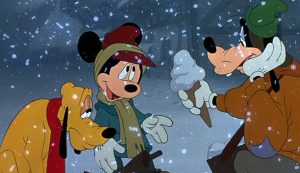 Goofy is Mickey’s good-natured but bumbling pauper friend who later befriends the Prince and saves his life. Donald is the Prince’s troublemaking valet who is well known for his pranks on the Prince while he is trying to study. Since he knows the Prince so well, he is also tossed into the dungeon to prevent him from revealing the switched identities although that is not clearly explained in the film.
Goofy is Mickey’s good-natured but bumbling pauper friend who later befriends the Prince and saves his life. Donald is the Prince’s troublemaking valet who is well known for his pranks on the Prince while he is trying to study. Since he knows the Prince so well, he is also tossed into the dungeon to prevent him from revealing the switched identities although that is not clearly explained in the film.
Pluto is still Mickey’s dog and best pal and the only one who can instantly tell Mickey and the Prince apart by his keen sense of smell.
This is the only Mickey film appearance to open with a storybook like the ones used in many of the Disney animated features.
This film was the final time that Disney used the Xerox process to transfer artists original drawings directly onto the final cel, a process that the studio had used for the previous three decades. Some objects, such as the carriage, were created on computers before being printed out on paper and Xeroxed onto animation cels.
It didn’t even go through the CAPS process and a lot of the production work was handled at Dale Baer’s studio. Scribner said that they referenced Brave Little Tailor (1938) “for the watercolor look. We wanted to resurrect that.” Daan Jippes did storyboards and character designs for the film.
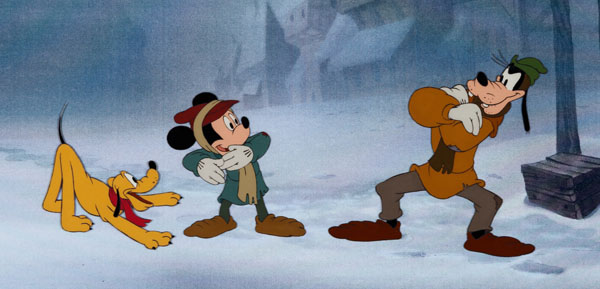
Merrie Olde England is not very merry in this version. The beloved King of England lies on his deathbed while his Captain of the Royal Guard Pete plunders the country for his own benefit.
The young Prince is oblivious to these outrages because he is locked away with constant lessons and royal duties to prepare him to take on the responsibilities of king when his ill father dies. He wears a shiny gold ring on his right hand.
He longs for the same freedom to just occasionally play enjoyed by his subjects. Mickey Mouse is a pauper boy who longs for all the comfortable luxuries of being a king including bountiful food and warm shelter. He desperately struggles to sell bits of kindling in wintertime to buy a few morsels of food
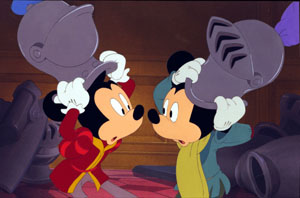 Caught in the castle trying to retrieve his lost dog Pluto, Mickey meets the Prince who looks exactly like him and they agree to exchange places for a day.
Caught in the castle trying to retrieve his lost dog Pluto, Mickey meets the Prince who looks exactly like him and they agree to exchange places for a day.
After the old king dies, villainous Captain Pete discovers the deception and throws the Prince into the dungeon to be killed once Mickey is crowned. Crafty Pete holds Pluto hostage to force Mickey into doing his every command.
Fortunately, with the help of Goofy and Donald Duck, the dastardly plot is revealed and just moments before the coronation, evil Pete and his weasel guards (once again the villainous weasel characters from the 1949 The Adventures of Ichabod and Mr. Toad) are defeated. The Prince is crowned and again brings joy back to the land with his just and compassionate rule.
Scribner fondly remembers working on The Prince and the Pauper: “You know, of all the things I’ve done, I’m probably the proudest of that featurette. I had a lot of latitude. I could direct it my own way. We took characters that you didn’t ordinarily think could be placed in that kind of drama.
 “To place a character like Mickey Mouse, a fairly one-dimensional figure, at the bedside of the death of the king, I thought we’d pull it off because we tried to do it with a lot of restraints. It was really a joy to work on and I’ve learned probably more from doing that film than I did for Oliver.
“To place a character like Mickey Mouse, a fairly one-dimensional figure, at the bedside of the death of the king, I thought we’d pull it off because we tried to do it with a lot of restraints. It was really a joy to work on and I’ve learned probably more from doing that film than I did for Oliver.
“In a lot of ways it was simpler, with simple characters that didn’t have to be designed – they were all there – but it had its own challenges: can we pull off with these characters a fairly traditional story? Can we place a flat cartoon character in that situation where the father of the real prince passes away without being laughable, that Mickey Mouse is just pretending to act? And I think it worked!”
Supervising animator of Mickey Mouse was Andreas Deja who recalled, “This was fun as it was Mickey Mouse in a dual role. We also tried to make it look like something that was done in the early 1940s (the look of the film and the character) and it was really fun to research the character very thoroughly and get to know Mickey Mouse.
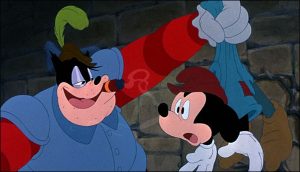 “The short wasn’t as cohesive in the end as it should have been – the story was a little convoluted and for a short there was just too much story that had to be told. But it was still fun to work on.
“The short wasn’t as cohesive in the end as it should have been – the story was a little convoluted and for a short there was just too much story that had to be told. But it was still fun to work on.
“I remember working very hard to distinguish the TWO Mickeys. One is a prince; one is a pauper. Same look, different personalities and behavior. I tried to portray the Pauper with submissive acting, while the Prince is confident and in charge. He’s the authority.
“This turned out to be a fun assignment, even though the film’s overall story is somewhat scattered. Thinking back, I just remember how much I enjoyed animating Mickey Mouse.”
Talented Wayne Allwine provided the voices for both characters and it was the first time where he had to sing as the character with the Rigoletto pastiche having new lyrics written by Jenny Tripp.
While not necessarily a memorable film, it is definitely charming and probably inspired Mickey, Donald and Goofy: The Three Musketeers (2004) that was directed by Donovan Cook – who was the coordinator on the production The Prince and the Pauper.


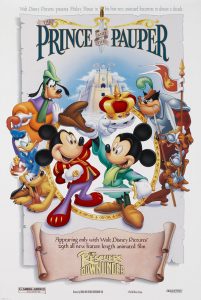
 Jim Korkis is an internationally respected animation historian who in recent years has devoted his attention to the many worlds of Disney. He was a columnist for a variety of animation magazines. With his former writing partner, John Cawley, he authored several animation related books including The Encyclopedia of Cartoon Superstars, How to Create Animation, Cartoon Confidential and Get Animated’s Animation Art Buyer’s Guide. He taught animation classes at the Disney Institute in Florida as well as instructing classes on acting and animation history for Disney Feature Animation: Florida.
Jim Korkis is an internationally respected animation historian who in recent years has devoted his attention to the many worlds of Disney. He was a columnist for a variety of animation magazines. With his former writing partner, John Cawley, he authored several animation related books including The Encyclopedia of Cartoon Superstars, How to Create Animation, Cartoon Confidential and Get Animated’s Animation Art Buyer’s Guide. He taught animation classes at the Disney Institute in Florida as well as instructing classes on acting and animation history for Disney Feature Animation: Florida.




















































The narrator of “The Prince and the Pauper” was Roy Dotrice, father of Disney Legend Karen Dotrice, whom we all remember as Jane in “Mary Poppins”.
Horace Horsecollar seems to be channeling Ben Stein. Among the royal duties on the list he prepared for the prince was “Sit for Holbein”. In the Mark Twain novel the prince is identified as Edward Tudor, the future King Edward VI and the only son of Henry VIII and his third wife Jane Seymour. Before his accession to the throne at age nine, the young prince had his portrait painted by Hans Holbein the Younger. A cute blink-and-you’ll-miss-it art history joke.
I’d have loved it if, in the coronation scene, the Archbishop of Canterbury had been an ape instead of an owl, because one of the archbishop’s titles is “Primate of All England”.
They should have given this featurette a second release with Disney’s remake of “The Parent Trap”.
Horace seems to me to be channeling Jim Backus more than Ben Stein. Love that voice.
I second that. Definitely Backus.
Here is the rare intermission sequence: https://www.youtube.com/watch?v=2Jv7BM509xc which not found on any home video release.
Thanks for this, I’m not 100% sure but I believe Rescuers Down Under was the first film I saw theatrically, which would make Prince and the Pauper the first narrative I experienced in a cinema. That would have included this sequence, presuming this intermission made it to the UK.
None of the animation looks as good Daan Jippes’ storyboards.